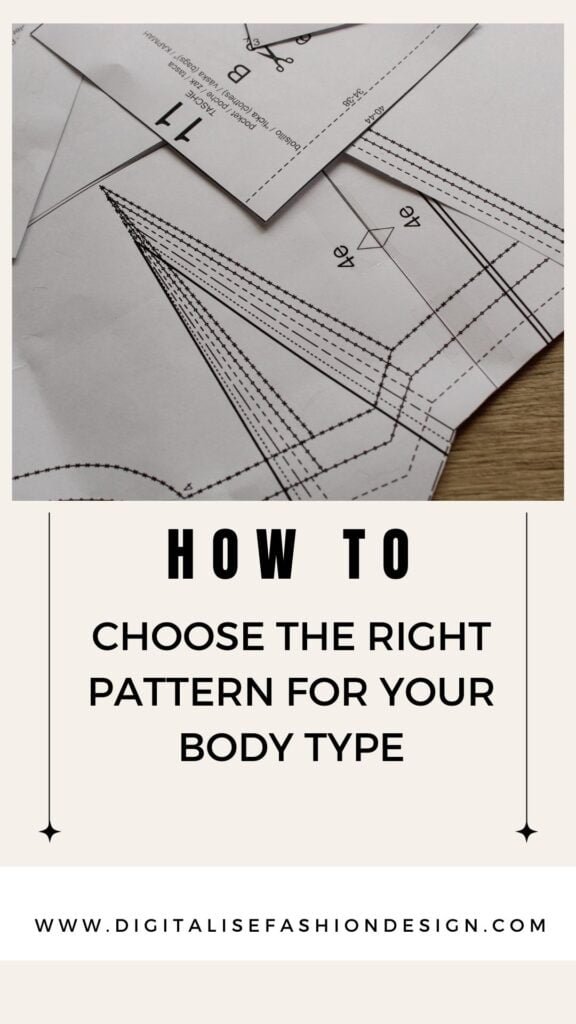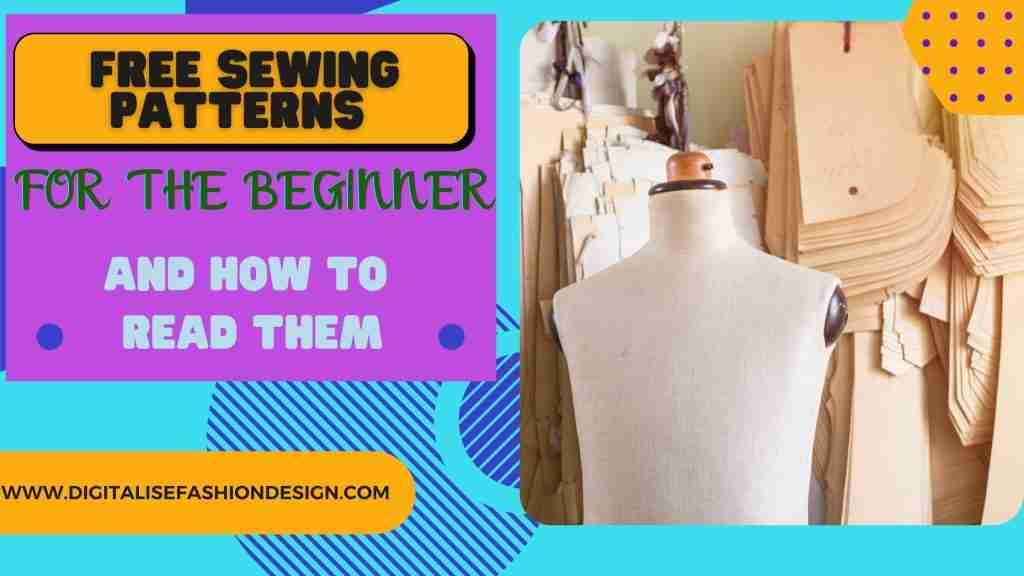The right sewing pattern is very important when it comes to your body type.
At the heart of any sewing project is the sewing pattern, This makes sewing less stressfull, and guides you from fabric to finished garment. A sewing pattern serves not just as a template for cutting your fabric but also as a roadmap for construction, ensuring that each piece fits together perfectly.
Understanding Sewing Patterns
You’ll want to familiarize yourself with the sewing pattern envelope. This contains essential information to help you understand what the pattern offers. You’ll find the pattern description on the envelope, which gives you an idea of the garment’s fit, style, and any unique features it may have.
There is also the size chart available on the back of most envelopes or within PDF sewing patterns to determine your size.
Importance of body measurements for choosing a sewing pattern

Unlike ready-to-wear sizes, a sewing pattern require you to select a size based on your actual body measurements.
It’s important to use a measurement guide and to understand the difference between body measurements and the garment’s finished measurements, which can significantly affect comfort and the overall look of the piece.
To measure your body, you’ll need a flexible tape measure.
Focus on the following key measurements: bust, waist, hip, and back length from base of neck to waist. It’s best to take these measurements wearing minimal clothing and to have someone assist you to ensure accuracy.
Measuring your body for your sewing pattern
If you would like additional insights and tips to help you take your body measurements with precision, check out my complete guide to body measurements to refine your measuring technique and lay the foundation for beautifully fitted garments.
Sometimes you will need to take a high bust measurement. The high bust measurement is taken above the full bust, under the arms, and around your back. This measurement is necessary for individuals who have a significant difference between their full bust and high bust sizes, as it provides a more accurate representation of the body’s frame size.
Choosing a pattern size based on the high bust measurement ensures that the neck, shoulders, and upper chest areas of the garment will fit properly.
Knowing your height is very important when choosing a sewing pattern because it directly impacts the fit and proportion of the finished garment. Most sewing patterns are designed with a standard height in mind—typically around 5’5″ to 5’6″ for women’s and misses’ patterns.
Translating Measurements to pattern size
Once you have your measurements, compare them with the well-intended size charts provided by the pattern company. It’s common to fall between sizes in different areas. To select the appropriate pattern size, consider the following factors:
- For skirts & pants, choose the size based on your hip measurement.
- For upper body garments, select the size using your bust measurement or high bust measurement.
- Pay attention to the waist measurement, especially if it falls into a different size category. Adjust the pattern accordingly.
Selecting the right sewing pattern for your skill level
When choosing a sewing pattern, consider your skill level. Beginners should look for patterns labeled as “Easy” or “Beginner-Friendly.” These patterns generally require simple techniques and are forgiving of minor mistakes.
- Beginner: Look for patterns that encourage learning basic skills, such as straight seams, simple darts, and elastic waistbands. Patterns that include fewer pieces, clear instructions, and minimal fitting are ideal.
- Intermediate: At this stage, you can explore patterns with more details, such as zippers, buttons, and different types of seams. Intermediate patterns offer a bit more challenge without being overwhelming.
- Advanced: Advanced sewists can tackle complex patterns, which include intricate sewing techniques, detailed fitting adjustments, and premium finishes.
Before purchasing a sewing pattern, review the instructions and required techniques to ensure they align with your current abilities. Your experience will be much more rewarding when you select a pattern suitable for your skill level.
OTHER RELEVANT BLOG POST
Design Choices for your sewing pattern
Pattern catalogs and envelopes are treasure trovels of information. Examine the pictures or drawings to get a sense of the garment’s style. Look for specific design elements like necklines, shoulder construction, and overall silhouette.
Begin with the visual representations—photos or drawings. These visuals present a clear picture of the finished piece, indicating whether it’s form-fitting or more relaxed in style.
Understanding Suggested Fabrics
Sewing patterns typically include a list of suggested fabrics, which are highly recommended for the best results.
It’s essential to consider the fabric’s properties, such as drape, stability, and texture, when choosing the right fabric for your pattern.
Before settling on a pattern, scrutinize the recommended fabrics listed on the envelope.
Pattern makers test their designs with various textiles to guide consumers toward the most compatible fabric choices.
Essential notions for your sewing pattern
In addition to selecting the right fabric, you’ll also need an array of essential notions for your sewing project. These include:
- Buttons: Get the proper size, shape, and style of buttons that match your fabric and garment design.
- Elastic: Choose the right type, width, and length of elastic for your project, such as waistbands or cuffs.
- Thread: It’s important to select a matching thread that complements the color and material of your fabric.
Having the right notions at your disposal will significantly improve your sewing experience and the final outcome of your project.
If you found this tutorial helpful, don’t forget to save the pinterest pin to your sewing board for future reference on selecting the right sewing pattern.
Conclusion
That is my take on how to choose the right sewing pattern for your sewing project.I hope you got some tips from the blog post.
If you have any questuions , please drop your coments below.dont forget to follow me on pintertest.








